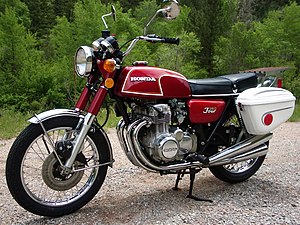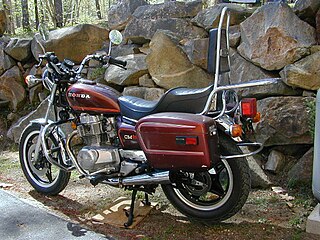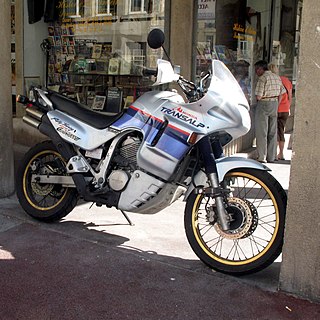

The CB Series is an extensive line of Honda motorcycles. Most CB models are road-going motorcycles for commuting and cruising. The smaller CB models are also popular for vintage motorcycle racing. [1] The related Honda CBR series are sport bikes.


The CB Series is an extensive line of Honda motorcycles. Most CB models are road-going motorcycles for commuting and cruising. The smaller CB models are also popular for vintage motorcycle racing. [1] The related Honda CBR series are sport bikes.
* Note: unless otherwise stated the engine capacity in ccs can be derived from the number in the model reference.

The Honda Hawk GT (NT650) motorcycle was designated as model RC31 and was designed by Toshiaki Kishi, and was the second Honda with "Pro-Arm" suspension bike after the RC30 VFR750R. The RC model designation is for bikes up to 750 cc, though the Honda Pacific Coast (PC800) has an engine of more than 750 cc and a model designation of RC34.

The Honda CB750 is an air-cooled, transverse, in-line-four-cylinder-engine motorcycle made by Honda over several generations for year models 1969–2008 with an upright, or standard, riding posture. It is often called the original Universal Japanese Motorcycle (UJM) and also is regarded as the first motorcycle to be called a "superbike".

The designation CB400 has applied to ten Honda motorcycle families:
One of the lines of Honda motorcycles is the CM Series and CMX Series of cruiser-style motorcycles. Some of the CM series engines existed in other motorcycles so we included them in this list. Some of the bikes using the CM/CMX engine or model line have been:

The Honda CB400F is a motorcycle produced by Honda from 1975 to 1977. It first appeared at the 1974 Cologne motorcycle show, Intermot, and was dropped from the Honda range in 1978. It had an air-cooled, transverse-mounted 408 cc (24.9 cu in) inline four-cylinder engine with two valves per cylinder operated by a single chain-driven overhead camshaft. Fuelling was provided by four 20 mm Keihin carburettors. The CB400F is commonly known as the Honda 400 Four.

The Honda CM400 is a street bike produced by the Honda Motor Company from 1979 to 1982, part of a series of motorcycles with the prefix 'CM' using various engine capacities. It was a precursor to the Honda Rebel series of motorcycles. It was equipped with electric start and electronic ignition. Models included the CM400A, CM400C (Custom), CM400E (Economy) and CM400T (Touring). The CM400C was produced only in 1981, making it one of the rarer models.

The Honda CB350F is a four-cylinder, four-stroke, 347 cc (21.2 cu in) motorcycle based on the larger versions of the day. The motorcycle was manufactured by Honda in Japan from 1972 to 1974. At the time, the CB350F was the smallest capacity four cylinder motorcycle ever to enter into full-scale production. There were no changes to the 1973 model, but Honda designated the 1974 bike the CB350F1.

The Honda CB500 Four is a standard 498 cc (30.4 cu in), air-cooled, 8-valve, SOHC, transverse inline-four motorcycle made by Honda from 1971 to 1978. It was introduced at the London Racing and Sporting Motorcycle Show in February 1972, and sold in the US market until 1973, replaced by the CB550 in the 1974 model year, while continuing in the European market until 1978. The CB500 Four is styled like the CB750, but smaller and lighter, with a claimed 50 bhp (37 kW) output and a top speed of 115 mph (185 km/h).

The Honda CL450 was the dual sport or "scrambler" model of Honda's 450 cc (27 cu in) DOHC parallel-twin engined motorcycle. It was the sister bike to the Honda CB450; the differences between the models were mostly cosmetic, with the CL450 having off-road-style high-level exhaust pipes and braced handlebars, for instance.

The Honda CB900C is a cruiser motorcycle produced by Honda from 1980 to 1982 primarily for the American market. It was succeeded by the CB1000C in 1983.

The Honda Transalp is the XL400V, XL600V, XL650V, XL700V, and XL750 series of dual-sport motorcycles manufactured in Japan by Honda since 1987. With the exception of XL750, the Transalp bikes series feature a liquid-cooled, four-stroke 52° V-twin engine.

The Honda CBF500 is a standard motorcycle made by Honda between 2004 and 2007. It is the Euro-2 compliant replacement of the Honda CB500. It has a 56 hp (42 kW), 499 cc parallel twin, and a top speed of 125 mph (201 km/h). It was discontinued after 2007 as new Euro-3 standards become mandatory in EU, the natural replacement is the bigger inline-four 600 cc powered Honda CBF600.

The Honda CM450A is a motorcycle made by Honda in 1982 and 1983. It was based on the CB400 and CM400 models (1978–1981), especially the CM400A Hondamatic (1980–1981). It had a 447 cc (27.3 cu in) SOHC parallel twin engine with two carburetors and a two-speed transmission with a torque converter. It was not a full automatic, however, because the rider had to manually shift between low and high. It is called automatic because there is no clutch required due to the torque converter, and shared the Hondamatic trade name with Honda cars that had true automatic transmissions. The chain-driven CM450A had a top speed of 90 miles per hour (140 km/h) and weighed 413 pounds (187 kg). Both models had a front disc brake and a rear drum brake. The suspension consisted of two shock absorbers at the rear and telescoping shock-absorbing front forks. The fuel tank had a 3.4 US gallons capacity. The exhaust was routed through a separate pipe and baffle on each side of the motorcycle, although both exhaust pipes shared a plenum under the motor. It had an electric start with a kick start as well.

The Honda CB650 is a 627 cc (38.3 cu in) standard motorcycle produced from 1979 to 1985. It featured a four-cylinder, SOHC, air-cooled, wet sump engine, with two valves per cylinder. The CB650 was a development of the CB550, itself derived from the even earlier CB500. The CB650 was the last of Honda's successful series of air-cooled SOHC fours that began in 1969 with the Honda CB750.
The Honda CB900F is a Honda motorcycle made in two iterations which appeared some twenty years apart. Both generations of the CB900F are straight four-cylinder four-stroke 900 cc (55 cu in) roadsters.
The Honda Dream CB250 was a standard motorcycle made by Honda in 1968 and 1969 and sold only in Japan. It had a 249 cc (15.2 cu in) air-cooled, parallel twin, SOHC, four-stroke with a claimed 30 horsepower (22 kW) at 10,500 rpm. It was Honda's first 250 cc capacity motorcycle with vertical cylinders and a 5-speed transmission.

The Honda CB400T is a range of motorcycles built by Honda. In the United Kingdom it was known as the Dream, whereas in the United States it was known as the Hawk. A Honda CB250T version was also available for UK licensing reasons.

The Honda CB400 Super Four is a CB series 399 cc (24.3 cu in) standard motorcycle produced by Honda at the Kumamoto plant from 1992 to the present. The CB400 embodies the typical Universal Japanese Motorcycle produced through the 1970s, updated with modern technology. To this end, the bike has a naked retro design, paired with a smooth inline-four engine. Originally a Japan-only bike, it was later also available in SE Asia, and from 2008 in Australia.

The Honda CB150R Streetfire is a CB series 150 cc (9.2 cu in) single-cylinder standard/naked bike made by Astra Honda Motor in Indonesia since late 2012. It is positioned above the more economical Verza in Astra Honda Motor's sport motorcycles lineup.

The Honda 500 twins are a series of straight-twin motorcycles made by Honda since 2013.
For a list price of $530, a young rider who may have started on a step-through Honda 50 or 90 got something that looked like a true motorcycle. And the 161cc single-overhead cam, four-stroke twin delivered on that promise, spinning up to 10,000 rpm and generating 16.5 horsepower—enough, the company claimed, for a top end of 75 mph. In a road test, Cycle World even dubbed the new bike a 'baby Super Hawk.'
This HONDA motorcycle is designed and produced as a compact version of the HONDA 250 Super Sports model CB-72